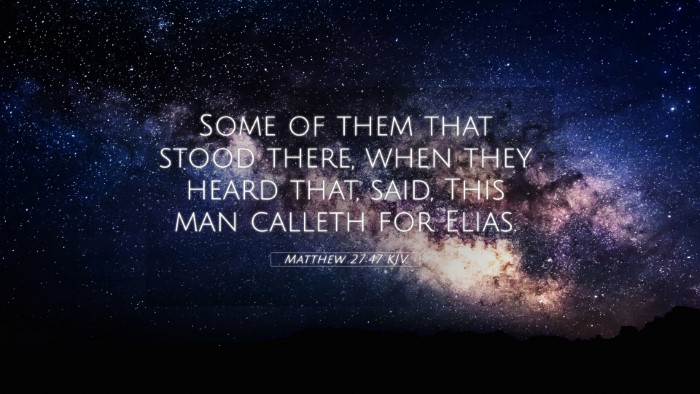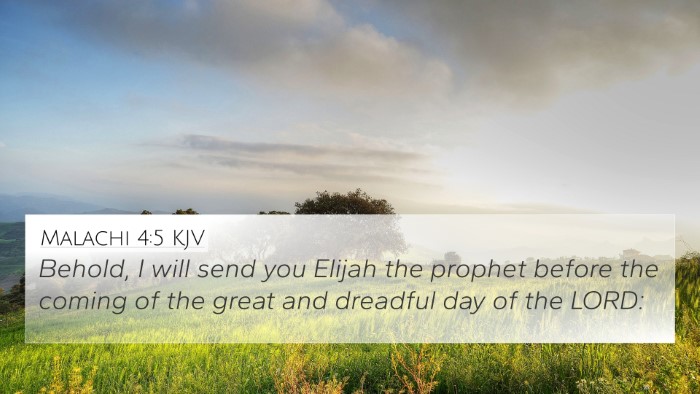Meaning of Matthew 27:47
Verse Reference: Matthew 27:47 - "Some of those standing there heard it and said, 'He is calling Elijah.'" (NIV)
Summary of Interpretation
The scene depicted in Matthew 27:47 occurs during the crucifixion of Jesus, a pivotal moment in the New Testament narrative. In this verse, onlookers misinterpret Jesus' cry, believing He is calling for the prophet Elijah, which reveals both their understanding and the prophecy associated with His suffering.
Insights from Commentaries
- Matthew Henry: Henry emphasizes the significance of the misunderstanding by the crowd. He notes that their response indicates a lack of spiritual insight, mistaking Christ's anguished call for a summons to Elijah, whom they revered as a great prophet.
- Albert Barnes: Barnes explains that the crowd may have thought Jesus was seeking supernatural help from Elijah, a figure they expected to reappear in troubled times. This reflects a deeper yearning within them for signs and wonders, rather than an understanding of Jesus' identity as the Messiah.
- Adam Clarke: Clarke points to the cultural context, noting that some Jews believed Elijah would come before the coming of the Messiah. The misunderstanding serves to highlight the disconnect between the expectations of the people and the reality of Jesus as the suffering servant foretold in the prophecies.
Bible Verse Cross-References
Matthew 27:47 may be understood more profoundly by considering its connections with several other scriptures:
- Malachi 4:5: "Behold, I will send you Elijah the prophet before the great and awesome day of the LORD comes." - This verse speaks to the expectation of Elijah's return, illustrating the crowd's misunderstanding.
- Matthew 16:14: "And they said, 'Some say John the Baptist, others say Elijah, and others Jeremiah or one of the prophets.'" - This highlights the prevalent belief in Jesus' prophetic identity.
- John 19:28: "After this, Jesus, knowing that all was now finished, said (to fulfill the Scripture), 'I thirst.'" - Here, we see the fulfillment of multiple Old Testament prophecies concerning the suffering Messiah.
- Psalms 22:1: "My God, my God, why have you forsaken me?" - This cry from Jesus reflects despair that resonated with His audience, leading to their misunderstanding.
- Mark 15:35-36: "And some of the bystanders hearing it said, 'Behold, he is calling Elijah.' And someone ran and filled a sponge with sour wine, put it on a reed and gave it to him to drink, saying, 'Wait, let us see whether Elijah will come to take him down.'" - This further illustrates the echo of expectations present during the crucifixion.
- Luke 9:8: "And by some that Elijah had appeared, and by others that one of the old prophets had risen again.” - This reference emphasizes the confusion surrounding Jesus' identity as it relates to prophetic figures.
- Hebrews 1:1-2: "Long ago, at many times and in many ways, God spoke to our fathers by the prophets, but in these last days he has spoken to us by his Son..." - This underscores the culmination of prophetic revelation in Jesus, challenging the notions held by the crowd.
Thematic Connections
The themes woven through Matthew 27:47 emphasize misunderstanding, prophecy fulfillment, and the recognition of Jesus as the central figure in God’s redemptive plan. The misinterpretation by the onlookers sheds light on their expectations of a Messiah who would deliver them from physical oppression, rather than acknowledging His sacrificial role.
Cross-Referencing Biblical Texts
Utilizing cross-references provides a richer understanding of Matthew 27:47. Tools such as a Bible concordance and Bible cross-reference guide facilitate deep studies into the layered meanings of Scripture. Through methods of cross-referencing Bible study, one can trace the connections between Jesus' crucifixion and Old Testament prophecies, leading to stronger thematic insights.
Conclusion
The statement in Matthew 27:47 not only reflects a moment of confusion but serves as a crucial point for understanding the fulfillment of prophecy and the identity of Jesus in the gospel narrative. Through comprehensive Bible cross-reference materials, one can discover the rich tapestry of connections that reveal the continuity of God’s word and purpose across both the Old and New Testaments.
Further Study Suggestions
To deepen understanding:
- Engage in detailed cross-reference studies between the Gospels.
- Explore Old Testament prophetic texts that foreshadow the crucifixion.
- Utilize Bible reference resources to research similar themes across the Scriptures.
- Consider the implications of inter-Biblical dialogue in enhancing understanding of Jesus’ mission.





